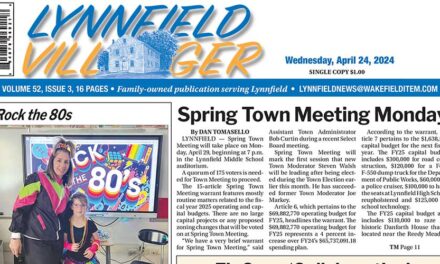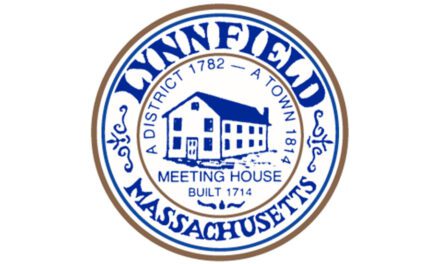Published in the February 3, 2016 edition
By MAUREEN DOHERTY
LYNNFIELD — Fire Chief Mark Tetreault presented a budget request for Fiscal Year 2017 of $2,119,809 to the Board of Selectmen that is nearly 13.5 percent higher than FY ’16.
The bulk of the 13.46 percent combined increase over the final FY ’16 budget of $1,868,400 comes from the addition of two career firefighting positions. According to the chief, these positions are necessary to overhaul the way the department is staffed to provide coverage 12 hours per day, seven days a week versus the current 8 a.m. to 4 p.m. model that has heavy reliance on evening and weekend callbacks.
Tetreault believes this model will improve safety for the town and alleviate pressure on the call staff, thus reducing turnover, and cut down on overtime, which will save the town money. It is the first major overhaul of the staffing model since about 1970. He said the staffing plan is supported by Town Administrator Jim Boudreau.
Specifically, under his budget proposal, the Fire Department operations line item increases by 31.8 percent, from $1,051,532 in the current fiscal year to $1,385,893 proposed in FY ’17. New career hires would also be required to be paramedics, which is a much higher level of training with a corresponding higher level of pay.
Tetreault’s operating budget also decreased the Fire Department’s EMS Enterprise account by 13.09 percent, or nearly $80,000, from $665,000 in FY ’16 to $577,926 next year. The difference is accounted for by having firefighters/EMTs already present at the station for calls that come in between 4-7 p.m.
Rounding out the operating budget is a modest 3.12 percent increase in the Fire Department administration line item, from $130,473 to $134,538. In addition to the chief’s salary, this figure includes the cost of uniforms, telephone, subscription dues and other expenses, he said.
Lastly, his budget also includes a 0.27 percent increase in the salaries for Fire Alarm maintenance and testing services, parts and hardware, vehicle repairs and salaries attributed to that task ($21,395 in FY ’16 to $21,452 in FY ’17).
Crawford not yet on board
Tetreault said increases in discretionary items in his FY ’17 were made in line with the Boston Consumer Price Index at 0.7 percent “so we can keep pace with the cost of inflation, and increased cost of delivering services. It levels out the increases in the budget so I don’t have to come back” for changes to specific line items, he said.
“The largest increase are personnel lines and that is reflective of the new staffing and also includes some of the offsetting savings. In the operation side we don’t see as many offsetting savings because it’s based off fewer callbacks. Sixty percent of our callbacks are medical, so only 40 percent are the callbacks that come out of this line,” the chief explained.
Selectmen Chairman Phil Crawford was not convinced that the staffing model proposed by the chief is appropriate.
“I don’t necessarily agree with the new staffing plan as presented,” Crawford said. “This has certainly got to be discussed in detail between now and Town Meeting before I would say this board and particularly Town Meeting would (approve) a staffing plan that is going to cost the town another $300,000 to $400,000 for something that we aren’t really comfortable with that is even going to fix what you are hoping it is going to fix.”
Crawford said he had no concerns with other aspects of Tetreault’s proposed operating budget.
“This is still a serious work in process that is at its beginning stages,” the chairman said. “I know you put some time into it but we got to really look at that and see how much that is going to benefit your issues with your staff and possibly what other things we could do without adding that much to the budget,” Crawford said.
Selectman Tom Terranova said his concern was whether the staffing level proposed by the chief was “adequate to fix the problem. This is unusual because I’m never wanting to spend.
“There appears to be an issue for addressing the overtime needs with regular full-time staffing. I’m not totally on board with adding two new full time people. That’s one way to do it, and activating the call firefighters as much as possible,” is another way, Terranova said.
Tetreault explained that the call volume “begins to drop off around 7 p.m. and really is in a downhill slope until 10 p.m or 11 p.m.”
After presenting his plan in December to the board, Tetreault said he has spoken to as many call firefighters as possible about extending the daily shifts from 12 hours to 15 or 16 hours. While a few call firefighters thought the extended hours were a good idea, he said the “vast majority” indicated that the hours they are most available for callbacks was between 7 p.m. to 11 p.m., after they’ve had dinner with their families and before heading to bed “whereas if we cover the station until 10 p.m. or 11 p.m., the call people would be left with the late night calls and having to get out of bed,” Tetreault said.
Terranova suggested they could schedule the 7 to 11 p.m. time slot rather than leaving it as an on-call, but added, it’s important to him that they achieve “some harmony between the staff and accomplishing our goals, and the main goal is to keep Lynnfield safe.”
“You guys know how to service the people and keep everybody safe. We’re counting on your expertise, at least for me, for steering the ship. My goal is to make sure to keep everybody in Lynnfield safe,” Terranova said. “We really need you to drill down, do what you can to keep costs down as much as possible, but give the town the very best fire service and EMS service possible,” Terranova said.
“I truly believe the 12-hour plan is the most economical. It is a natural growth of our Fire Department from the 1970 model. It also incorporates our call people,” Tetreault said, which is the secondary goal of the plan, after ensuring public safety.
“Our call force is what has given us the operational efficiency that I don’t think a lot of other communities have,” the chief said, adding, “Even if we were to go with 24-hour coverage, we are going to spend a lot more for firefighters in the station and get less service because our call force brings so much more to the table than we could possibly afford to do with all career staff.”




